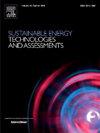Metal-doped (Fe-Mn) heteroatom-rich porous biochar-based poison-resilient cathode catalyst for enhanced performance of microbial fuel cell
IF 7.1
2区 工程技术
Q1 ENERGY & FUELS
Sustainable Energy Technologies and Assessments
Pub Date : 2025-01-30
DOI:10.1016/j.seta.2025.104208
引用次数: 0
Abstract
Developing cost-effective and superior catalysts for the oxygen reduction reaction (ORR) is paramount for successfully commercializing microbial fuel cells (MFCs) as a sustainable, reliable and economical alternative for energy recovery and wastewater treatment. In this investigation, metal-doped heteroatom (Nitrogen-Sulphur-Carbon) rich porous biochar (Metal-NSC) was synthesized by incorporating different metal and bi-metal dopants into activated human hair (HH) biochar. Out of which, the synthesized Fe/Mn-NSC catalyst has a porous structure that enables it to have a high specific surface area (615.04 m2/g), a large pore volume (0.4342 cm3/g), and numerous defects (ID/IG = 1.02). The Fe/Mn-NSC demonstrates exceptional performance in the ORR, and the performance of MFC using Fe/Mn-NSC as a cathode catalyst stands out with a higher power density (14.6 ± 0.6 W/m3), which was 1.74 and 1.14 times compared to only HH biochar (NSC) (8.4 ± 0.1 W/m3) and commercial Pt/C (12.8 ± 0.3 W/m3), respectively. Thus, the Fe/Mn-NSC catalyst exhibits promising potential to harvest more power per unit cost (64.69 mW/$) and superior alternative to commercial Pt/C catalyst (3.11 mW/$) for widespread deployment for practical applications in MFCs.

求助全文
约1分钟内获得全文
求助全文
来源期刊

Sustainable Energy Technologies and Assessments
Energy-Renewable Energy, Sustainability and the Environment
CiteScore
12.70
自引率
12.50%
发文量
1091
期刊介绍:
Encouraging a transition to a sustainable energy future is imperative for our world. Technologies that enable this shift in various sectors like transportation, heating, and power systems are of utmost importance. Sustainable Energy Technologies and Assessments welcomes papers focusing on a range of aspects and levels of technological advancements in energy generation and utilization. The aim is to reduce the negative environmental impact associated with energy production and consumption, spanning from laboratory experiments to real-world applications in the commercial sector.
 求助内容:
求助内容: 应助结果提醒方式:
应助结果提醒方式:


